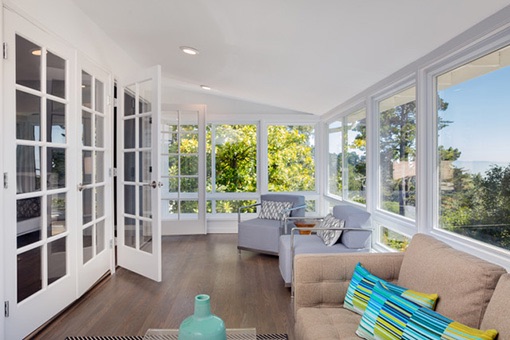Let the Sun Shine in with a Sunroom Addition
By: Steve Bonser
Among the popular room additions homeowners are choosing to make these days is the sunroom addition. Often also referred to as a solarium or conservatory, sunrooms additions are an extension of the home which create additional living space and provide an ideal area for relaxation and a view of the outdoors. Provided you have sufficient lot space, sunrooms are usually a solid investment, adding to your home’s value.
In many less temperate parts of the country, homeowners must choose if they want a four-season sunroom or one usable only during milder times of the year. The terms three-season and two-season sunroom refer to enclosures which offer insulation and heating best suited to ward off cold and damp during non-winter months. Here in California, our pleasant year-round weather lowers the bar (and cost) for building a sunroom which provides comfortable use anytime.
In previous generations many families created a pleasant indoor-outdoor space by converting porches and patios with screening, awnings and other modifications to keep insects, wind and direct sunlight at bay. Today, options for creating a sunroom are almost unlimited, making it possible to create an environment perfect for your family’s lifestyle and to your exacting specifications.
Here are considerations to discuss with your contractor to define the parameters of the design:
Structure and foundation
Due to the high frost line and sandy-clay soil composition, most homes in western and southern states are built on concrete slab foundations. This is an excellent choice for your sunroom as it provides a longer-lasting strength and structural integrity to the addition. The concrete is poured onto a leveled and gravel-filled area with deep footings around the perimeter. Insulation can be placed under the slab as well as PVC piping for electrical, plumbing and CAT-5 lines. Another option is a crawl space which elevates the structure off the ground and provides room for insulation. This also offers the benefit of wood flooring, a nice rustic touch which is not recommended over a slab due to the moisture levels from concrete.
A lower cost approach are pole footings. This eliminates the need to fully prep the ground beyond ensuring its level. Holes are dug out below the frost line (12 inches here in California) and cardboard tubes which are filled with concrete are inserted. The platform, typically made of treated lumber is built on the framework supported by the footings. Post and beam framing and glass walls are most popular choice for sunrooms and a combination of both can cover all the bases from a structural and functionality perspective. Aluminum framing is another option but has drawbacks mostly stemming from insulation challenges and long-term durability.
Cost factors to consider: preparation of the site and pouring a slab foundation, or construction of a crawl space, pole footings, or pole and beam framing.
Insulation
Unless you’re willing to close off your sunroom during the colder, rainy season, you’ll want to budget for walls, flooring and a roof which can provide thermal resistance. If you’re intent on having more square footage of glass or even a glass ceiling, you’ll want to factor that in when choosing heating, cooling and air circulation options. Windows and all glass barriers should be double pane and you should consider specialized treatments like inert, argon filling or low-emissivity coatings. Solar-treated, low emissivity (Low-E) glass, tinting and reflective film-treated glass can substantially keep energy costs down and keep the room cool.
Cost factors to consider: Insulation, windows, and optional sliding glass door.
Architectural aesthetic
There are several reasons to have your plans drawn up by your contractor or even an architect. You’ll need a permit in any case and the approval process is smoother and usually quicker with well- prepared blueprints. Also, to ensure the finished result has maximum eye appeal and complements the rest of your home, a professional design should integrate the addition with details you may overlook such as having same roofline with overhangs, matching the overall design (ranch, Craftsman, mid-century, Victorian, American colonial, etc.), and ensuring the materials, finishing and colors enhance its surroundings.
Cost factors to consider: Often included in the contractor’s quote; architecture design fees vary widely.
Heating, cooling and airflow
Even in balmy California, keeping the chill away is a necessity unless you plan to use the sunroom mostly during daylight during sunny, warm weather. Cooling and airflow are then your main concerns. If you want to avoid extending your HVAC ductwork into the addition, you may choose to rely on a space heater only. A better option is to install electric baseboard heaters which are virtually invisible and will distribute heat more evenly throughout the room.
There are also ductless or mini-split heat pumps which operate with a wall-mounted heater connected to an outdoor air compressor. These energy-efficient systems also provide a cooling function which is a big advantage over space heaters and baseboard units. Regardless if you go with an entirely glass-enclosed room or not, keeping the room comfortable necessitates air cooling. If you expand the vents from your central air conditioning system, the problem is solved. Regardless of your choice, one or two strategically placed ceiling fans can provide welcome relief during hot weather and offer the benefit of ambient lighting sources. With few choosing widow-mounted air conditioning systems in our area, you’re more likely to opt for the aforementioned ductless mini-split A/C system.
Cost factors to consider: Extending existing ductwork, purchase of baseboard heaters, or quality dual-function ductless system.
Discussing it over a cup of coffee on-site with the contractor will get your creative juices flowing and give them a running start on making your dream sunroom a reality.

